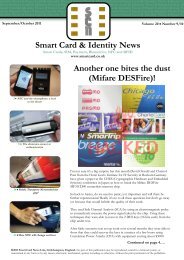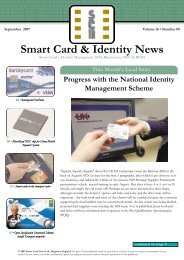Mifare, Oyster and ITSO Cards Hacked Smart Card & Identity News
Mifare, Oyster and ITSO Cards Hacked Smart Card & Identity News
Mifare, Oyster and ITSO Cards Hacked Smart Card & Identity News
Create successful ePaper yourself
Turn your PDF publications into a flip-book with our unique Google optimized e-Paper software.
Versatile Hardware Security With<br />
Cryptographic RF <strong>Smart</strong>cards<br />
By Eustace Asanghanwa, Atmel<br />
Affordable True Hardware Security for Mutual Authentication <strong>and</strong> Data Security<br />
Cryptographic RF smartcards offer true hardware-based security for applications that<br />
need authentication, value storage, identification, <strong>and</strong> secure access control. It bridges<br />
the complexity <strong>and</strong> affordability gap between high-end secure microcontroller-based<br />
smartcards used in banking, <strong>and</strong> low-end cards used for loyalty tracking <strong>and</strong> access<br />
control, without giving up security.<br />
Eustace Asanghanwa<br />
Developers <strong>and</strong> service providers can now apply the desired amount of security to their applications without<br />
the complexity <strong>and</strong> unit costs associated with high-end smartcards. Additionally, there is no tradeoff in<br />
security for low-end smartcards. Example applications include:<br />
‣ Subscription management including cable <strong>and</strong> satellite TV.<br />
‣ Electronic purses used in Laundromats, energy meters, internet café resources <strong>and</strong><br />
transportation.<br />
‣ Information cards including ID cards <strong>and</strong> driver licenses.<br />
‣ Multi-application cards, for example, a single card that combines multiple functions like hotel<br />
access, mini-bar purchases, movie purchases, <strong>and</strong> secure access to [high-value] in-room hotel<br />
safes.<br />
<strong>Smart</strong>cards are available today for a wide range of applications <strong>and</strong> are classifiable under two broad<br />
categories: Microprocessor-based <strong>and</strong> memory-based smartcards. Microprocessor-based smartcards embed a<br />
microprocessor, volatile <strong>and</strong> non-volatile memories, <strong>and</strong> communication circuitry such as Analog Front-End<br />
(AFE) in an integrated circuit that eventually embeds inside the st<strong>and</strong>ard smartcard. They contain<br />
cryptographic routines either in firmware or hardware accelerators to service high-end security applications<br />
like banking <strong>and</strong> passports. They require special software or operating system developed by security experts<br />
for effective security. Their complex nature allows them to comm<strong>and</strong> premium prices in the market. In<br />
addition, these smartcards require external power to support the energy requirements of the microprocessor,<br />
the memories <strong>and</strong> the cryptographic routines. For this reason, their connectivity to the outside world is<br />
usually contacted in nature, at least for power sourcing. Contacted connectivity dem<strong>and</strong>s periodical card<br />
replacement due to worn out contacts. In the rare cases where connectivity is not contacted, as in RFID<br />
cards, power limitations translate into long transaction times making them less practical for mainstream<br />
security applications.<br />
Figure 1: A high level block diagram of a microprocessor smartcard<br />
<strong>Smart</strong> <strong>Card</strong> & <strong>Identity</strong> <strong>News</strong> • January 2008<br />
11
















